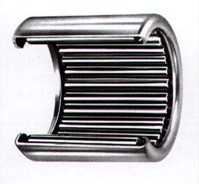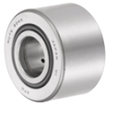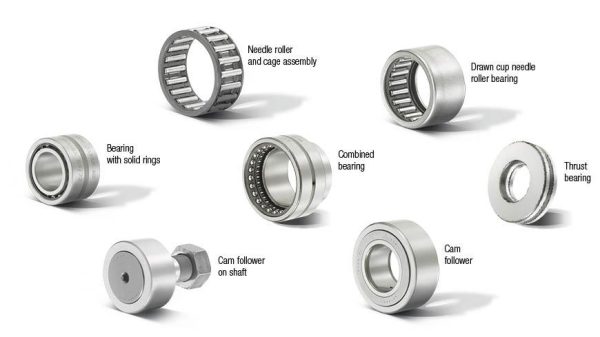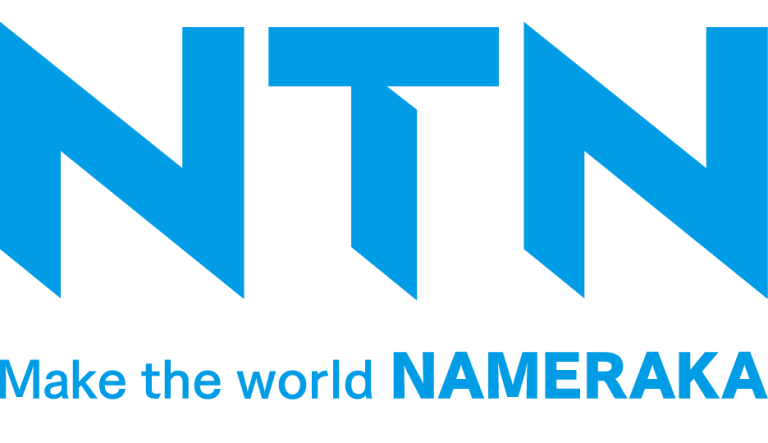Characteristics of needle bearings
The needle roller bearing did not get its name by chance, because its rolling elements are – surprise – characterised by a needle shape! The rolling elements are also guided parallel to the axis, as needle roller bearings are a special type of cylindrical roller bearing. You are almost guaranteed to find needle roller bearings in gearboxes, vehicle drives or packaging machines, for example.
Needle roller bearings are mainly used as non-locating bearings. Typical for this type of bearing are also its very compact dimensions. Here and there, the inner and/or outer ring may be missing, and the same applies to the cage. If the cage is missing, it is also called a “full complement needle roller bearing”. Needle roller bearings have a small cross-section and are therefore smaller than many other bearing types. This is because the rolling element diameter is smaller than 10 millimetres. The diameter-length ratio of the rolling elements is between 1:3 and 1:10.


Because their rolling elements are relatively long and the contact with the raceways is linear, as in cylindrical roller bearings, needle roller bearings achieve the highest load rating in the smallest installation space and can be used with high radial loads. In addition to their compactness, another advantage is that needle roller bearings are characterised by high rigidity. These bearings are also particularly well suited for applications in which they do not have to perform complete revolutions, but are only pivoted through an angle. In contrast to other bearing designs, the areas overlapped by the rolling elements on the raceways occurs even with small movements due to the small rolling element spacing. This makes it possible to counteract the poor lubrication conditions that often exist in these pivoting applications. In addition, their modular design means that they are not normally difficult to mount. Moreover, needle roller bearings are usually associated with low costs, especially in relation to their performance – pretty good, right?
The disadvantage of needle bearings is the increased noise level – especially compared to ball bearings. As mentioned before, needle bearings are ideal for radial loads, but conversely they are not suitable for axial loads. If needle bearings without an inner or outer ring are to be used, care must be taken to ensure that the bearing journals in the area of the shaft or housing have sufficient hardness and also meet high requirements for dimensional and concentric running accuracies. Another aspect that should be taken into account is that needle roller bearings are only suitable for high speeds and high temperatures to a limited extent. This is particularly important for full complement bearings, whose rolling elements rub against each other due to the missing cage. Special attention must be paid here to lubrication in order to keep friction as low as possible.
Needle cages (needle roller and cage assemblies)
There are various needle bearing series, the most important of which are presented here. First of all, needle cages, also called needle roller and cage assemblies, should be mentioned. These run directly on the shaft or housing, so that the shaft and housing replace the classic bearing raceways. Needle roller and cage assemblies are a cost-effective variant of the rolling bearing, mainly because they are light and compact and require little space. At the same time, however, high demands are placed on the surface finish and hardness of the thin cages. The basic form with a highly rigid cage can be recognised by the abbreviation K, but there are numerous different forms of needle roller and cage assemblies.


Drawn cup needle roller bearings
Drawn cup needle roller bearings are characterised by a deep-drawn outer ring that is manufactured by forming. This is characterised by a low wall thickness of sheet steel and is very thin. High precision tolerances of the housing bore are the main requirement for the use of drawn cup needle roller bearings. A characteristic feature of drawn cup needle roller bearings is that in most cases they do not have an inner ring. As with needle roller and cage assemblies, there are many different types. The basic type is called HK. Drawn cup needle roller bearings can also have a seal integrated in the deep-drawn outer ring on one or both sides. There are also variants of this type which are completely closed on one side. All types of drawn cup needle roller bearings are also known as shell type needle roller bearings.
Solid ring needle roller bearings
Another needle roller bearing series are the solid ring needle bearings; these are characterised by a solid outer ring, which is also known from cylindrical roller bearings. The rigidity of solid needle bearings is higher than that of other needle bearing types. The bearings are therefore suitable for applications with high speeds, high loads and high demands on rotational accuracy. Solid ring needle roller bearings can also have an oil groove with holes in the outer ring.


Stud type track rollers
Another type of needle roller bearing is the stud type track roller. Stud type track rollers have a stub shaft and perform intermittent, oscillating and continuous rotary motions with high accuracy and high speed. They are used as a cam control mechanism for drive units and are ideal for packaging machines that can roll over the outer raceway during production.
Yoke type track rollers
Last but not least, yoke type track rollers are important, but unlike the stud type track rollers, they do not involve a stub shaft. On the one hand, like stud type track rollers they can also fulfil the function of a cam mechanism, but on the other can function as a guide or support roller for straight or curved tracks. Both yoke type track rollers and stud type track rollers have a solid outer ring that can withstand impact loads. There are two types of outer surface; it can be either cylindrical or crowned.


Sealing of needle bearings
What role do seals actually play in connection with needle bearings? Basically, open needle bearings, and thus bearings without seals, are more common than bearings with seals. Irrespective of this, it is possible to install a seal directly in both machined and deep-drawn needle roller bearings. A contact seal made of nitrile rubber is used as standard for needle roller bearings. With needle roller and cage assemblies, however, a seal must be used in the direct vicinity of the bearing. Here, the rolling bearing manufacturer NTN has seals that are directly matched to the height of needle bearings and can thus effectively protect the bearing from foreign particles. The special GD seal is particularly advantageous compared to the G seal, as it has a better sealing effect and thus retains grease. In addition, particle ingress is prevented.

Further information on seals can also be found at bearingwizard.co.uk. In addition, you will also find other considerations that go together with the design of a bearing arrangement, including bearing mounting, the difference between a locating (fixed) and non-locating (floating) bearing arrangement and the arrangement types.
You may also be interested in
Lifetime calculation
Damn, bearing damage! If you consider that rolling bearings are exposed to continuous pressure and shear stress, this is nothing unusual to begin with. What
Lubrication
Nothing works without lubrication: Every bearing runs with grease or oil lubrication, which is the basic prerequisite for avoiding metallic contact of the bearing components,
Point and line contact
What is meant by “point and line contact”? You may have already heard that rolling bearings can be split into two types. The classification depends
Rolling bearing types overview
If you have read our article on rolling bearing basics, you probably already know that rolling bearings can basically be divided into two types –
Sealing
During the design of a bearing assembly, the topic of sealing will always accompany you. In the following material, we will cover both integrated and
Structure and function
Components of rolling bearings The basics of rolling bearing technology include the structure and function of rolling bearings. To get you started slowly, you will




